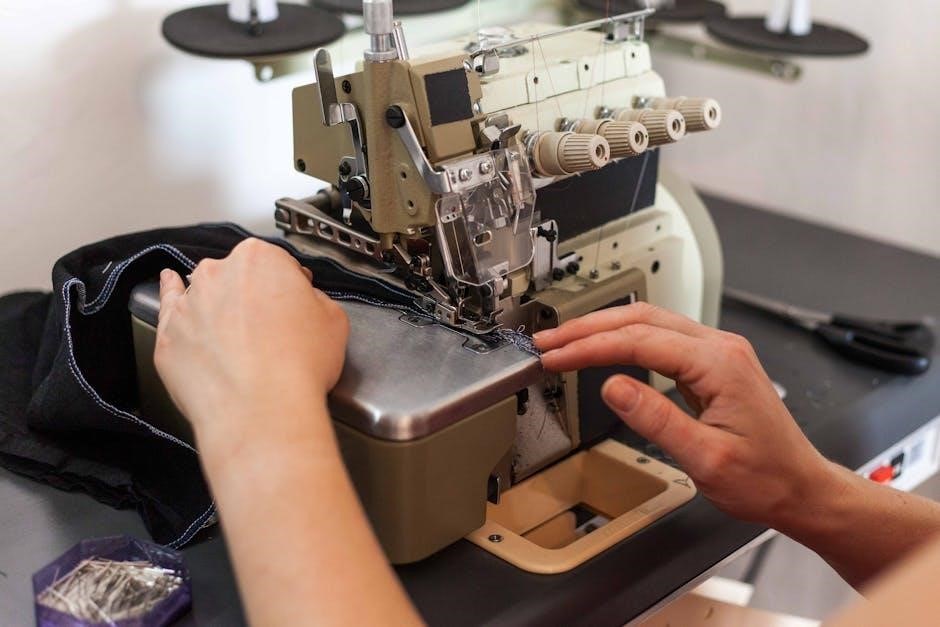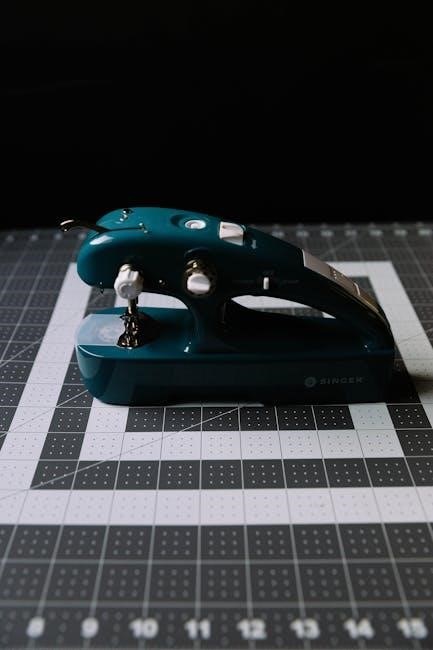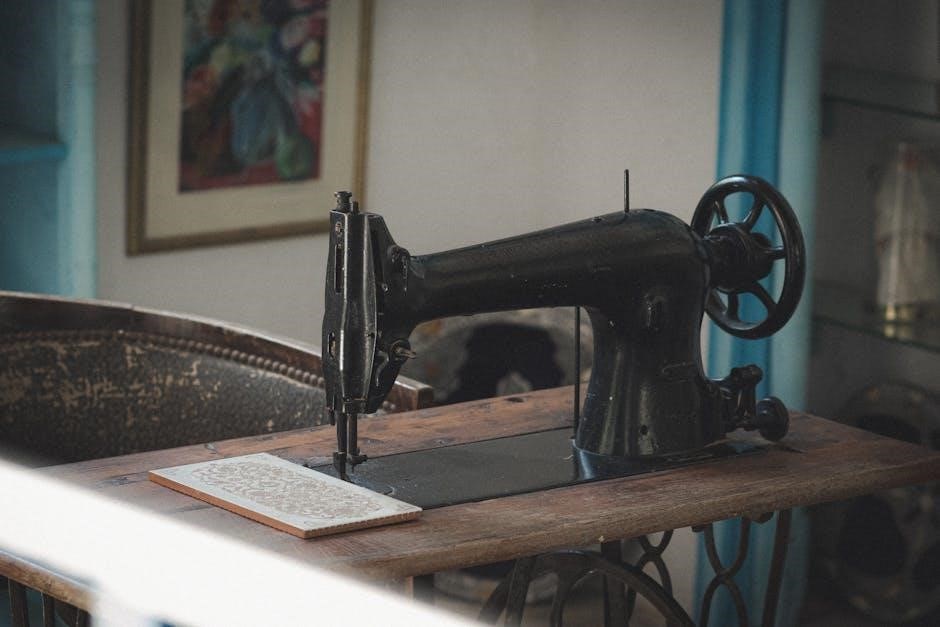Singer sewing machine manuals provide essential guidance for operating, maintaining, and troubleshooting various models.
They include user manuals, service guides, and stitch tutorials.
These resources are vital for both vintage and modern machines.
Whether you’re a novice or an experienced sewer, Singer manuals offer comprehensive support.
They ensure optimal performance and longevity of your sewing machine.
1.1 Importance of Manuals for Sewing Machines
Singer sewing machine manuals are crucial for understanding machine operation, maintenance, and troubleshooting.
They provide detailed instructions for setup, threading, and using various stitches.
Manuals ensure safe usage by outlining electrical safety and handling precautions.
They also guide users in resolving common issues, preventing damage and extending machine lifespan.
Having a manual helps maximize the machine’s potential and enhances sewing efficiency.
For both beginners and experienced users, Singer manuals are indispensable for optimal performance and creativity.
1.2 Brief History of Singer Sewing Machines
Singer Sewing Machines, founded by Isaac Singer in 1851, revolutionized sewing with the first practical machine.
Known for innovation, they introduced the first electronic model in the 1970s and computerized models in the 1990s.
As part of SVP Worldwide, they remain a global leader, offering models from vintage Featherweight to heavy-duty, ensuring quality and durability.
Their impact spans home sewing and industrial applications, maintaining a trusted reputation for over 170 years.
1.3 Purpose of the Article
This article serves as a comprehensive guide to Singer sewing machine manuals, providing detailed insights and practical advice.
It aims to help users understand and utilize their manuals effectively, covering setup, maintenance, and troubleshooting.
Whether you’re a novice or an experienced sewer, this guide offers essential information.
It also highlights resources for downloading manuals and accessing additional support.
By following this guide, you’ll optimize your sewing machine’s performance and extend its lifespan.
Discover how to make the most of your Singer sewing machine with this invaluable resource.

Types of Singer Sewing Machine Manuals
Singer sewing machine manuals include user manuals, service manuals, stitch guides, and maintenance guides.
Each type provides specific instructions for operation, repair, and care.
They cater to different user needs and skill levels.
These manuals ensure optimal machine performance and longevity.
2.1 User Manuals
User manuals for Singer sewing machines are essential for understanding basic operations and features.
They provide step-by-step instructions for setting up the machine and performing various stitches.
Topics include threading, bobbin installation, and selecting stitch patterns.
These guides are designed for both novice and experienced users.
They often include diagrams and troubleshooting tips to help resolve common issues.
Available in multiple languages, Singer user manuals ensure seamless operation for sewers worldwide.
They are accessible as free PDF downloads from Singer’s official website or authorized third-party sites.
2.2 Service Manuals
Singer sewing machine service manuals are designed for advanced users and professionals.
They detail technical specifications, lubrication procedures, and repair guidelines.
These manuals are crucial for maintaining and servicing older or complex models.
They often include diagrams for timing the needle movement and adjusting internal mechanisms.
Service manuals are particularly useful for vintage machines like the Singer 27K or 301.
They can be downloaded for free from Singer’s official website or third-party archives.
Regular servicing, as outlined in these manuals, ensures optimal performance and extends the machine’s lifespan.
2.3 Stitch Guides
Singer sewing machine stitch guides provide detailed instructions for various stitch patterns and settings.
They help users understand how to select and customize stitches for different fabrics and projects.
These guides are essential for maximizing the machine’s capabilities.
They often include visual diagrams and step-by-step tutorials.
Stitch guides are particularly useful for novice sewers to improve their skills.
They can be downloaded alongside user manuals or purchased separately.
Having a stitch guide ensures seamless operation and enhances creativity in sewing projects.
It’s a valuable resource for both basic and advanced stitching techniques.
2.4 Maintenance Guides
Singer sewing machine maintenance guides offer detailed tips for keeping your machine in optimal condition.
They cover cleaning, lubrication, and regular upkeep tasks.
These guides help prevent mechanical issues and extend the machine’s lifespan.
Key topics include oil application points and frequency.
They also advise on cleaning the bobbin area, feed dogs, and tension discs.
Maintenance guides often include schedules for part inspections and replacements.
Proper care ensures smooth operation and consistent stitch quality.
By following these guides, users can avoid common problems and maintain their machine’s performance.
Regular maintenance is crucial for both vintage and modern Singer models.

How to Download Singer Sewing Machine Manuals
Download Singer sewing machine manuals from the official Singer website or third-party sites like Manualslib.com.
Free PDF downloads are available for various models, including Featherweight and Heavy Duty.
Visit the Singer support page for direct access to user and service manuals.
Ensure compatibility with your machine model for accurate guidance.
3.1 Official Singer Website
The official Singer website is the most reliable source for downloading sewing machine manuals.
It offers free PDF downloads for various models, including Featherweight, Heavy Duty, and computerized machines.
Users can browse by model number or product type to find specific guides.
The website also provides multilingual support, ensuring accessibility for global users.
Additionally, it features updates, stitch guides, and maintenance tips.
Visitors can access comprehensive resources to optimize their sewing experience.
This official platform is trusted for accurate and detailed information.
3.2 Third-Party Websites
Third-party websites offer an alternative to downloading Singer sewing machine manuals.
Popular platforms like Manualslib.com, Etsy, and SewingNZ provide free PDF downloads.
These sites often include vintage and hard-to-find manuals for Featherweight, Heavy Duty, and other models.
Users can search by model number or product type to find specific guides.
While convenient, ensure the reliability of the source to avoid misleading information.
These platforms are especially useful for accessing manuals for discontinued models.
They cater to both novice sewers and collectors of vintage machines.
3.4 Free PDF Downloads
Free PDF downloads of Singer sewing machine manuals are widely available online.
Third-party websites like Manualslib.com and Etsy offer free access to PDF manuals for various Singer models.
These manuals are often scanned from original Singer documents and converted to PDF format.
Free PDF downloads provide instant access to user guides, maintenance tips, and troubleshooting information.
They are particularly useful for owners of vintage models or those who have lost their original manual.
Many websites offer free PDF downloads in multiple languages, catering to a global audience.
This resource is invaluable for sewers seeking detailed instructions without cost.
3.5 Language Options for Manuals
Singer sewing machine manuals are available in multiple languages to cater to a global audience.
English, Spanish, French, and German versions are commonly found online.
Some manuals also include translations in Finnish, Danish, Norwegian, and Swedish.
Third-party websites and Singer’s official site often provide language options.
This ensures that users worldwide can access instructions in their native tongue.
Language diversity makes Singer manuals universally accessible.
Users can easily find and download manuals in the language they prefer.
This feature enhances the usability of Singer sewing machines globally;

Setting Up Your Singer Sewing Machine
Setting up your Singer sewing machine involves unpacking, initial setup, threading, bobbin installation, and tension adjustment.
These steps ensure smooth operation and help you start sewing quickly.
- Unpack and inspect the machine for any damage.
- Follow the manual for proper assembly and placement.
- Thread the machine correctly as per the guide.
- Install the bobbin and adjust tension settings.
4.1 Unpacking and Initial Setup
Unpacking and initial setup are crucial for your Singer sewing machine’s proper functioning.
Start by carefully removing the machine from its packaging and inspecting for any damage.
Refer to the manual for assembly instructions, ensuring all parts are securely attached.
Place the machine on a stable, flat surface and plug it in safely.
Before use, double-check that all components are correctly aligned and functioning.
This step ensures a smooth start to your sewing journey.
- Inspect the machine for any signs of damage or wear.
- Follow the manual’s assembly guide for attaching accessories.
- Position the machine on a stable work surface.
- Plug in the machine and test basic functions.
4.2 Threading the Machine
Threading your Singer sewing machine correctly ensures smooth stitching and prevents thread breakage.
Start by turning the machine off and locating the spool pin.
Gently pull the thread through the tension discs, leaving a small loop.
Guide the thread through the take-up lever and needle bar.
Insert the thread into the needle’s eye from front to back.
Always use high-quality thread suitable for your fabric type.
Refer to your manual for specific threading diagrams tailored to your model.
- Ensure the machine is turned off before threading.
- Use the correct thread type for your fabric.
- Leave a small loop at the tension discs.
- Thread the needle from front to back.
- Consult the manual for model-specific guidance;
4.3 Bobbin Installation
Proper bobbin installation is crucial for smooth stitching in your Singer sewing machine.
Start by turning off the machine and locating the bobbin case.
Remove any remaining thread from the previous bobbin.
Place the new bobbin into the case, ensuring it sits correctly.
Pass the thread through the bobbin case slot and pull gently.
Handwind the bobbin until it is evenly filled.
Replace the bobbin case into the machine, aligning it properly.
Make sure the thread is not tangled or twisted.
Refer to your manual for specific bobbin installation steps.
- Always turn off the machine before starting.
- Use the correct type of bobbin for your machine.
- Ensure the thread is properly seated in the case.
- Handwind the bobbin smoothly and evenly.
- Consult the manual for model-specific instructions.
4.4 Adjusting Tension
Proper tension adjustment is essential for achieving balanced stitches on your Singer sewing machine.
Start by threading the machine correctly and checking the bobbin tension.
Adjust the upper thread tension by turning the dial, ensuring it is not too tight or loose.
Test the tension by sewing a few stitches on scrap fabric.
If the stitches are uneven, tweak the tension settings accordingly.
Refer to your manual for specific tension adjustment guidelines.
Regularly checking and adjusting tension prevents fabric bunching or loose stitching.
- Begin with the standard tension setting for your machine.
- Use the manual’s tension guide for precise adjustments.
- Make small changes and test the stitches each time.
- Ensure the bobbin tension complements the upper thread tension.
- Consult the manual if tension issues persist.

Maintenance and Troubleshooting
Regular maintenance ensures optimal performance of your Singer sewing machine.
Cleaning, lubrication, and tension adjustments are essential tasks.
Identify and resolve common issues promptly to avoid damage.
Refer to your manual for troubleshooting guides and solutions.
5.1 Cleaning the Machine
Cleaning your Singer sewing machine regularly is crucial for maintaining its performance.
Use a soft brush or compressed air to remove lint and debris from the bobbin area and tension discs.
Ensure all ventilation openings are free from dust and fabric remnants.
For metal parts, a gentle cloth slightly dampened with water can be used, but avoid harsh chemicals.
Regular cleaning prevents mechanical issues and ensures smooth stitching.
Refer to your Singer manual for specific cleaning instructions tailored to your model.
5.2 Lubrication Tips
Proper lubrication is essential for the smooth operation of your Singer sewing machine.
Use high-quality sewing machine oil to lubricate moving parts, such as the bobbin hook and gears.
Refer to your manual for specific lubrication points and recommended products.
Apply a few drops of oil where metal parts move against each other.
Avoid over-lubrication, as excess oil can attract dust and cause maintenance issues.
Lubricate periodically, ideally every 50 hours of use, to maintain optimal performance.
Always turn off and unplug the machine before lubricating for safety.
5.3 Common Issues and Solutions
Common issues with Singer sewing machines include thread bunching, fabric jams, and uneven stitches.
Check thread tension and ensure proper bobbin installation to resolve bunching.
Clear jams by gently removing fabric and rethreading the machine.
Uneven stitches may result from incorrect needle size or tension settings.
Consult your manual for guidance on adjusting these elements.
If the machine doesn’t power on, inspect the foot controller and electrical connections.
Regular cleaning and lubrication can prevent many of these issues.
Refer to troubleshooting guides in your manual for detailed solutions.
5.4 Resetting the Machine
Resetting your Singer sewing machine can resolve various operational issues.
Start by turning off the machine and unplugging it from the power source.
Wait for 10-15 seconds to allow internal components to reset.
Plug it back in and turn it on to test if the issue is resolved.
For computerized models, refer to the manual for specific reset procedures.
Some machines may require pressing a combination of buttons to restore default settings.
Regular resets can help maintain optimal performance and prevent software glitches.
Always consult your manual for model-specific instructions.

Singer Sewing Machine Models and Their Manuals
Singer offers various sewing machine models, each with dedicated manuals.
Featherweight, Heavy Duty, Vintage, and Computerized models have manuals available as free PDF downloads online.
6.1 Featherweight Models (e.g., 222K, 301)
The Singer Featherweight models, such as the 222K and 301, are renowned for their portability and durability.
These vintage machines are highly sought after by sewing enthusiasts.
Their manuals, available as free PDF downloads, provide detailed instructions for operation, maintenance, and troubleshooting.
Users can find these guides on platforms like ManualsLib and Etsy.
The manuals cover topics like threading, bobbin installation, and stitch selection.
They also include tips for maintaining the machine’s performance and addressing common issues.
Whether you’re a collector or an active user, these resources ensure optimal use of your Featherweight Singer sewing machine.
6.2 Heavy Duty Models (e.g., 4423, 4432)
Singer Heavy Duty models like the 4423 and 4432 are designed for robust sewing tasks, handling thick fabrics with ease.
Their manuals, available in multiple languages, provide detailed setup and maintenance instructions.
Downloadable PDF guides from Singer’s official website and third-party sources ensure accessibility.
These manuals cover heavy-duty stitching, troubleshooting common issues, and optimizing machine performance.
Users can also find tips for maintaining the machine’s durability and ensuring smooth operation.
The Heavy Duty models are popular among professionals and hobbyists alike, supported by comprehensive documentation.
6.3 Vintage Models (e.g., 27K, 28K)
Singer’s vintage models, such as the 27K and 28K, are cherished for their durability and timeless design.
Their manuals, available as free PDF downloads, provide detailed instructions for operation and maintenance.
These guides are compatible with multiple vintage Singer models, including the 127K and 128K.
Enthusiasts and collectors can access these manuals from archives like Manualslib.com and Etsy.
The manuals offer comprehensive guidance on stitching, lubrication, and troubleshooting.
They are indispensable for preserving the functionality and heritage of these classic machines.
Vintage Singer manuals ensure seamless operation for both novice and experienced users.
6.4 Computerized Models
Singer’s computerized sewing machines, like the Quantum Stylist series, offer advanced features such as programmable stitches and USB connectivity.
Their manuals provide detailed instructions for navigating digital interfaces, customizing settings, and troubleshooting.
These guides are available as free PDF downloads from Singer’s official website.
They include step-by-step tutorials for Wi-Fi setup, software updates, and syncing designs.
The manuals also cover maintenance tips specific to computerized models, such as screen calibration and system resets.
With these resources, users can fully utilize their machine’s innovative capabilities and ensure optimal performance.

Accessories and Attachments
Singer sewing machines offer a variety of accessories, including extension tables, buttonholers, and specialized feet.
These attachments enhance functionality for tasks like quilting, embroidery, and heavy-duty sewing.
Manuals provide guidance on installation and usage.
7.1 Compatible Accessories
Singer sewing machines support a wide range of compatible accessories, enhancing versatility and performance.
These include extension tables for larger projects, buttonholers for professional finishes, and specialized feet for zippers, quilting, and embroidery.
Additional attachments like foot controllers and carrying cases are also available.
Manuals detail how to install and use these accessories effectively.
They ensure seamless integration, optimizing your sewing experience.
Compatible accessories are designed to meet specific needs, from basic repairs to intricate designs.
Referencing the manual helps in selecting the right tools for your projects.
7.2 Buttonholers and Other Attachments
Singer sewing machines often come with buttonholers and other specialized attachments to enhance stitching capabilities.
Buttonholers simplify creating professional-looking buttonholes with precise measurements.
Other attachments include cording feet, quilting feet, and zipper feet, each designed for specific tasks.
Manuals provide detailed instructions on installing and using these attachments effectively.
They ensure proper alignment and tension for optimal results.
Singer offers a variety of optional attachments to suit different fabrics and sewing techniques.
These tools expand the machine’s functionality, making it versatile for various projects.
Referencing the manual helps in selecting the right attachment for your needs.
7.3 Extension Tables
Extension tables for Singer sewing machines provide additional workspace, making it easier to manage large or bulky fabrics.
They are ideal for quilting, home decor projects, or sewing heavy-duty materials.
These tables attach securely to the machine, offering a stable surface for smooth stitching.
When removed, the machine converts to a free-arm model for sewing cuffs, trouser legs, and other hard-to-reach areas.
Manuals often include instructions for proper installation and maintenance of extension tables.
Regular cleaning and alignment ensure optimal performance.
Using an extension table enhances precision and comfort during extended sewing sessions.
7.4 Foot Controllers
Foot controllers for Singer sewing machines allow for hands-free operation, enabling better control over fabric movement.
They are essential for maintaining consistent stitching speed and tension.
Regularly clean and inspect the foot controller to ensure proper function.
Keep ventilation openings free from lint and dust to prevent overheating.
Some models offer adjustable sensitivity for customized control.
Manuals provide guidance on connecting and calibrating foot controllers.
Proper use enhances sewing efficiency and reduces fatigue.
Always refer to the manual for specific maintenance tips.

Safety Precautions
Always keep ventilation openings free from lint and dust to prevent overheating.
Ensure electrical components are dry and avoid operating near water.
Never touch moving parts with fingers or loose clothing.
Keep children away from the machine while in use.
Regularly clean the machine to maintain safe operation.
8.1 General Safety Guidelines
Always read the manual before using your Singer sewing machine to understand safety instructions.
Keep ventilation openings free from lint and dust to prevent overheating.
Avoid operating the machine near water or in humid environments.
Never touch moving parts with fingers or loose clothing.
Use only approved Singer accessories to ensure safe operation.
Keep children away from the machine while it is in use.
Regularly clean and maintain the machine to prevent mechanical issues.
Follow all electrical safety guidelines to avoid shocks or fires.
Ensure the machine is placed on a stable, flat surface during operation.
8.2 Ventilation and Airflow
Proper ventilation is crucial for maintaining your Singer sewing machine’s performance and longevity.
Keep all air vents and openings free from lint, dust, and loose fabric to ensure smooth operation.
Regularly clean the machine, especially after heavy use, to prevent debris buildup.
Place the machine in a well-ventilated area, away from walls or curtains that may obstruct airflow.
Use a soft brush to gently remove lint from vents and internal components.
Avoid blocking the foot controller or machine openings, as this can lead to overheating.
Ensure your sewing space is well-ventilated to prevent dust and lint accumulation.
Proper airflow helps maintain optimal temperature and prevents mechanical issues.
8.3 Handling Moving Parts
Always handle moving parts of your Singer sewing machine with care to avoid injury and damage.
Keep fingers and loose clothing away from the needle, bobbin area, and other moving components.
Use the provided handles or grips when adjusting or servicing parts.
Ensure the machine is turned off and unplugged before cleaning or servicing.
Regularly inspect belts, gears, and other parts for wear and tear.
Never force parts to move; if stuck, consult the manual or contact a professional.
Teach children to stay away from moving parts to prevent accidents.
Proper handling ensures safety and extends the machine’s lifespan.
8.4 Electrical Safety
Ensure your Singer sewing machine is used with proper electrical precautions to prevent hazards.
Always plug the machine into a grounded outlet to avoid electrical shock.
Keep the machine away from water and moisture to prevent damage or injury.
Never touch electrical components with wet hands or while standing on a damp surface.
Inspect power cords regularly for frays or damage; replace if necessary.
Unplug the machine when not in use or during maintenance.
Use only Singer-recommended adapters or extensions to maintain safety standards.
Consult a professional for any electrical issues or malfunctions.

Resources for Singer Sewing Machine Manuals
Access official Singer websites, third-party platforms, and online forums for free PDF downloads.
Visit repair shops or vintage archives for rare manuals.
Explore communities and support centers for tailored guidance and troubleshooting.
These resources ensure seamless access to Singer sewing machine manuals.
9.1 Official Singer Support
The official Singer website is the primary source for authentic sewing machine manuals.
It offers free PDF downloads for various models, including user manuals, service guides, and maintenance tips.
Users can access resources in multiple languages, ensuring global accessibility.
Singer’s official support also provides stitching guides and troubleshooting instructions.
Visit the Singer website to explore comprehensive manuals tailored to your specific sewing machine model.
This resource is ideal for both novice and experienced users seeking reliable guidance.
With official Singer support, you can ensure optimal performance and longevity for your sewing machine.

9.2 Online Communities and Forums
Online communities and forums are invaluable resources for Singer sewing machine users.
These platforms offer troubleshooting tips, user experiences, and access to rare manuals.
Members often share advice for vintage models like Featherweight and Heavy Duty machines.
Forums like ManualsLib and sewing enthusiast groups provide free manual downloads.
Users can discuss common issues and find solutions from experienced sewists.
These communities are especially helpful for vintage models with hard-to-find documentation.
Engaging with online forums enhances your sewing experience and helps maintain your machine effectively.
9.3 Repair Shops and Service Centers
Repair shops and service centers specialize in Singer sewing machine maintenance and repairs.
These professionals offer expert care for both vintage and modern models.
They often have access to rare manuals and parts for Featherweight and Heavy Duty machines.
Service centers can perform routine maintenance, repairs, and upgrades.
Many shops provide personalized advice for optimal machine performance.
They ensure your Singer sewing machine runs smoothly for years.
Visiting a certified service center is recommended for complex issues.
This support is crucial for preserving the longevity of your sewing machine.
9.4 Vintage Manual Archives
Vintage manual archives offer a treasure trove of historical Singer sewing machine guides.
These archives preserve original manuals for classic models like the Featherweight 222K and 301.
They provide detailed instructions for maintenance, lubrication, and troubleshooting.
Many archives are available as free PDF downloads or digital scans.
Enthusiasts and collectors rely on these resources to restore and operate vintage machines.
Archives like Manualslib.com and Etsy sellers specialize in vintage Singer manuals.
These documents are invaluable for understanding the evolution of sewing technology.
They ensure that older models remain functional and cherished for generations.